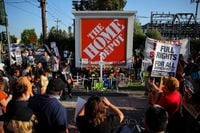On September 12, 2025, the U.S. Supreme Court quietly handed down a decision that is already sending shockwaves through communities across America. In a 6-3 ruling in Noem v. Vasquez-Perdomo, the Court used its so-called "shadow docket" to lift a lower court’s ban on Immigration and Customs Enforcement (ICE) “roving patrols” in Los Angeles. This decision, made without a full hearing or a published majority opinion, has ignited a fierce debate over constitutional rights, racial profiling, and the future of public safety in the United States.
According to Slate Magazine, the Supreme Court’s move gives ICE agents unprecedented legal cover to stop, question, and detain people based on their appearance, language, accent, workplace, or any other marker that an agent deems "suspicious." In plain terms, the ruling opens the door for racial profiling on a scale not seen in decades, affecting not only undocumented immigrants but also millions of Latino citizens and residents. The fear is palpable: everyday actions—speaking Spanish, waiting outside a store, or simply going to work—can now make someone a target.
What makes this decision even more controversial is the way it was issued. The Court used the shadow docket, a process typically reserved for procedural orders or rare emergency requests, which has increasingly been used to decide major issues—such as abortion, voting rights, and now, immigration profiling. Unlike cases on the "merits docket," shadow docket rulings bypass the transparency of full briefings, oral arguments, and written explanations. As a result, there is no clear legal guidance for lower courts or law enforcement, leaving much to interpretation—and potential abuse.
“When justice is delivered in the dark, rights disappear in the daylight,” one commentator wrote in Slate Magazine, highlighting the dangers of such opaque decision-making. The Fourth Amendment, which is supposed to protect all Americans from unreasonable searches and seizures, has always been a gray area when it comes to immigration enforcement. Previously, "reasonable suspicion" was the threshold for investigations, but this new ruling dangerously expands what counts as reasonable suspicion—now including race, accent, or even the neighborhood someone is standing in.
Justice Brett Kavanaugh played a pivotal role in the decision, penning a concurring opinion that explicitly supported ICE’s consideration of these factors in combination. He argued that as long as individuals carry identification, they should be fine. But as critics have pointed out, this view is detached from the reality faced by millions. How many people routinely carry a passport, birth certificate, or even a Social Security card? And even if they did, what’s to stop ICE from detaining or even assaulting someone before they have a chance to present their ID?
This isn’t just a hypothetical concern. The case of Jason Gavidia, a U.S. citizen born in Los Angeles, underscores the risks. Gavidia was thrown against a fence and assaulted by ICE agents despite repeatedly shouting, “I’m American!” According to reports, his identification was confiscated and never returned. "Next time he’s stopped, what proof does he have left?" the Slate Magazine podcast asked. For millions of Americans who share Gavidia’s background, the fear is not just theoretical—it’s lived experience.
Justice Kavanaugh, critics argue, is insulated from this reality by his race, class, and position. His assurances ring hollow for those who do not share his privilege. History, after all, is replete with examples of law enforcement abusing the leeway granted by vague legal standards. Arizona’s infamous “Show Me Your Papers” law allowed Sheriff Joe Arpaio to harass Latinos based on little more than skin color and accent. New York City’s stop-and-frisk program turned Black and Latino men into daily suspects until courts ruled it unconstitutional. Even darker chapters—like the internment of Japanese Americans or the slave patrols of the 19th century—remind us that racial profiling is not a new phenomenon. It’s an American tradition, one that resurfaces whenever the courts or politicians give law enforcement permission to indulge it.
Justice Sonia Sotomayor, in a forceful dissent, warned of the dangers this ruling poses. She wrote that ICE should never be allowed to stop people just for being Latino, calling the decision "a betrayal of constitutional values and a dangerous normalization of discrimination." She highlighted the slippery slope inherent in the majority’s reasoning: "The so-called ‘combination of factors’ argument is just a slippery slope toward the same abuses we have always seen." In her view, the decision will not only affect undocumented immigrants but also sweep up citizens and permanent residents, tainting entire communities with suspicion and fear.
The practical consequences could be dire. Real public safety, experts say, depends on trust between law enforcement and the communities they serve. When neighborhoods fear that an accent, a workplace, or a face is enough to trigger detention, cooperation with police evaporates. Victims and witnesses become reluctant to call 911, families stop reporting crimes, and neighborhoods retreat inward—not out of apathy, but out of self-preservation. As Slate Magazine noted, "ICE does not act alone. Information-sharing with local police is routine, which means the culture of profiling will bleed into local law enforcement, spreading fear even further."
The way the Supreme Court handled the case has drawn particular ire. By choosing the shadow docket, the justices avoided the scrutiny that comes with a full hearing and a published majority opinion. Critics argue this was by design: "They know that if people truly understood what had been decided, the outrage would be overwhelming." Instead, the decision was normalized quietly, with the hope that the next news cycle would bury it.
But this is unlikely to be the end of the story. Advocates, civil rights groups, and affected communities are preparing to fight back in court and in the public square. As the Slate Magazine podcast emphasized, "The Court sent a message to ICE: you are free to profile. And unless we push back, ICE agents will take that freedom and run with it, in Los Angeles, in Chicago, in Queens, and beyond." The question now is not just what ICE will do with this newfound authority—but what the American public will do in response.
Will the country accept a reality where Latino citizens are forced to prove their citizenship on demand, where language or accent alone can arouse suspicion, and where constitutional protections bend depending on how someone looks? Or will there be a renewed demand for a country where rights are not contingent on appearance, and law enforcement cannot terrorize communities under the guise of "reasonable suspicion"?
History has already shown where unchecked profiling leads. The only way to change course is to recognize what’s at stake and demand accountability—from the courts, from law enforcement, and from ourselves.



